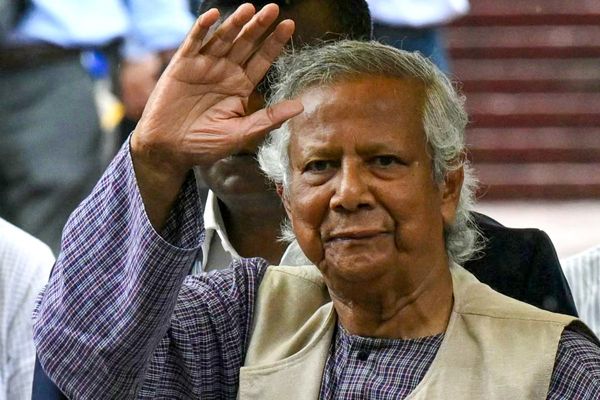President Donald Trump's trade-war roller coaster has moved on from Liberation Day chills to the thrills of China detente and Middle East deals for Boeing jets and Nvidia chips. That abrupt shift "from Tariff Man to global salesman," as investment strategist Ed Yardeni put it, revived an S&P 500 bull market in stocks.
Trump's ham-handed, on-again/off-again tariff declarations are arguably starting to look somewhat constructive. If Trump tariffs continue to de-escalate or at least hold steady, some $2 trillion in tax revenue over a decade could help stabilize federal debt. Tariffs may even provide some boost to U.S. manufacturing, if auto, pharma and tech companies follow through on pledges. Further, Germany and China have embraced aggressive stimulus amid Trump's tariff threats. That could help restore balance to a world that's grown too dependent on U.S. demand.
Yet markets may be looking past potentially unsettling twists and turns ahead, as recent headlines have underscored.
Tariff Price Hikes Are Coming
Walmart is warning of double-digit price hikes, a reminder that the lowered Trump tariffs still are historically high. Rising inflation, slower economic growth and few Fed rate cuts loom in the near term.
The 90-day U.S.-China trade-war truce on May 12 reactivated cargo ships loaded with toys, furniture, sports gear and apparel. But a week later, Beijing accused the U.S. of poisoning negotiations by seeking to freeze out Huawei's AI chips.
For other trade partners, Trump on April 9 granted a 90-day reprieve for reciprocal tariffs above 10%. But that pause is nearly half over, and the U.S. has only struck a preliminary UK deal. Trump now says that the U.S. can't realistically reach many deals in time, so it may just dictate terms. Translation: De-escalation could turn to re-escalation. And that doesn't even include the chance of additional tariffs on semiconductors, pharmaceuticals, copper and lumber that Trump has put on the back burner for now.
Moody's downgrade of America's bulletproof top credit rating a week ago wasn't directly related to the Trump trade war. But it does suggest a rocky start for simultaneously revamping U.S. trade and fiscal policy.
Some queasiness is to be expected as the U.S. tries to overhaul policies that Treasury Secretary Scott Bessent has painted as spinning out of control.
"This status quo of large and persistent imbalances is not sustainable," Bessent said on April 23. He said Trump was taking strong action to correct the effects of "policy choices by other countries (that) have hollowed out America's manufacturing sector and undermined our critical supply chains, putting our national and economic security at risk."
Bessent also acknowledged that the U.S. must "get our fiscal house in order."
Join IBD experts as they analyze leading stocks and the market on IBD Live
U.S. Budget Deficits Soar
As bloated federal deficits, now close to $2 trillion a year, boosted the consumption of imports, foreign investors piled into U.S. financial assets. That helped fuel S&P 500 gains, but a stronger dollar tilted the scales from U.S. manufacturing to China, Mexico and Southeast Asia.
Yet deficits look set to expand under the GOP budget reconciliation package, dubbed the "Big Beautiful Bill."
Even with Trump tariff revenue, "We expect the budget deficit to be broadly unchanged at close to 6% of GDP over the next few years," wrote Paul Ashworth, chief North America economist at Capital Economics. That would still leave the debt burden on track to reach nearly 120% of GDP by 2034. The U.S. debt is just under 100% of GDP today.
Trump, though, has signaled impatience with fiscal hawks in the House over their determination to curb Medicaid spending. He looks ready to push borrowing to new extremes, even amid a global trade war that could repel foreign capital.
The upshot is that the GOP fiscal package could keep upward pressure on interest rates amid higher tariff-driven inflation. That may drag against the onshoring investment Trump aims to promote.
A 10-year Treasury yield move past 4.5% might trigger a 5% haircut for the S&P 500, Morgan Stanley Chief U.S. Market Strategist Mike Wilson predicted after the Moody's downgrade. And the 10-year Treasury surged back above that level, hitting stocks on May 21.
Trump's China Tariff Cuts Revive Shipping Sector, For Now
The Trump Trade War Put
Markets have kept their poise in large part because Trump has stepped back multiple times to stem a sell-off. On April 9, Trump acknowledged that "yippy" bond investors led him to freeze the rollout of reciprocal tariffs.
In March, he largely reversed course just two days after he imposed 25% taxes on most Mexico and Canada imports. The move included autos and parts that complied with the successor to NAFTA negotiated in his first term.
On April 29, Trump subtly provided some tariff relief for two years on foreign parts used in U.S. auto plants. "We just wanted to help them during this little transition," Trump said.
The auto parts phase-in will help Elon Musk and Tesla avoid tariffs on EV batteries imported from China over the next two years.
Finally, on May 12 Bessent and Chinese negotiators announced that both sides would slash tariffs more than expected. The U.S. imposed a 30% duty on Chinese goods, while Beijing set a 10% rate on American wares. That reset the clock to April 2, before back-and-forth retaliation slammed the brakes on $600 billion in trade.
More than a markets reprieve, the China deal and earlier moves signal a tempered vision of what tariffs can accomplish. They also suggest a greater appreciation for the havoc they can wreak.
"While the Trump administration wanted to restructure the global trading system, it did not mean to implement a de facto trade embargo that led to the wholesale decoupling between the U.S. and China," wrote Seema Shah, chief global strategist at Principal Asset Management.
The key takeaway: "If the U.S. is not looking to redraw trade lines at the expense of near-term U.S. economic strength, there should be renewed confidence in the U.S. as an investment destination."
Reciprocal Tariff Reprieve Won't Last
Yet while the Trump trade war's recent direction has soothed markets, what happens when reciprocal tariffs' 90-day pause is over? Relatively few countries may reach an understanding with the U.S. before the July 8 deadline, Trump said last week. Other trading partners, he said, should expect a letter in the next two or three weeks stating "what they will be paying to do business in the United States."
Bessent said on May 18 that countries that don't negotiate in good faith can expect "April 2 level" reciprocal tariffs. He also raised the prospect of regional tariffs, instead of going country by country.
But after several Trump flip-flops, trading partners may be betting that his bark will again be worse than his bite.
UK Deal Shows Tariff Threat Limits
The one Trump trade deal, with the UK, is revealing. It "demonstrates the limits of foreign governments' willingness to yield to tariff bullying," Peter Morici, a University of Maryland economist focused on trade, wrote in a recent Washington Times column.
The Brits held firm on the digital services tax aimed at the likes of Google, Meta Platforms and Amazon.com, as well as curbs on U.S. chicken exports.
Further, the Rolls-Royce break on auto tariffs — 10% vs. the industrywide 25% — has Japan, South Korea and the European Union pushing for even greater relief. The EU has put retaliatory tariffs on standby.
Detroit automakers are fuming that Rolls-Royce could face lower tariffs than U.S.-assembled vehicles with 50% foreign content.
The U.S. and India are reportedly working on a deal that could open up market access to 1.4 billion consumers. Yet Trump put a cloud over those talks when he called out Apple CEO Tim Scott for his plan to shift U.S.-bound iPhone production out of China — but not to the U.S. "I don't want you to build in India," he declared.
The world should find out by July 8 whether Trump will be satisfied using his bully pulpit or whether he'll wield a bully club, raising tariffs further.
JPMorgan Chase CEO Jamie Dimon warned in a May 19 investor-day talk that markets were showing "an extraordinary amount of complacency." He fears a bout of stagflation, with higher inflation and depressed growth due to tariffs and stubbornly high interest rates. That could cut S&P 500 earnings growth to zero — down from double-digit expectations.
Trump Trade War Meets Tech Showdown
With trade talks seeming to bog down, Trump's recent Mideast trip showed that chips can provide more leverage than tariffs.
Trump's visits to Saudi Arabia and the United Arab Emirates "opened a trillion‑dollar floodgate of capital for AI infrastructure" investments built on American technology from Nvidia, AMD and much more, wrote SemiAnalysis founder Dylan Patel and co-authors.
The bilateral deals "reinforce America's claim to AI leadership" by ensuring that the world's next big artificial intelligence hub relies on U.S. hardware and software, Patel says. Those landmark deals came about as Trump ditched Biden administration rules constraining the spread of AI technology to keep it out of China's hands, notes Patel. He sees the security risks as manageable.
But there's a catch: On the same day as the U.S. and China revealed their surprisingly large tariff cut, the Trump administration said it would ensure America's "global AI dominance" in part by imposing criminal sanctions on companies "using Huawei Ascend chips anywhere in the world."
Beijing, which had agreed to reverse retaliatory measures, appears to be dragging its feet in easing export restrictions on rare-earth magnets. Those are key to EV motors, F-35 fighter jets, Tomahawk missiles and much more.
Musk said on an April 22 earnings call that Tesla was seeking a rare-earth export license from China. The magnets are needed to build thousands of Optimus humanoid robots by year-end.
The Pentagon reportedly has a limited stockpile of rare-earth magnets. But nonmilitary users could face trouble right away if Beijing takes a hard line.
Just as the U.S. and China had dialed down their trade war, they could be headed for a tech showdown.







